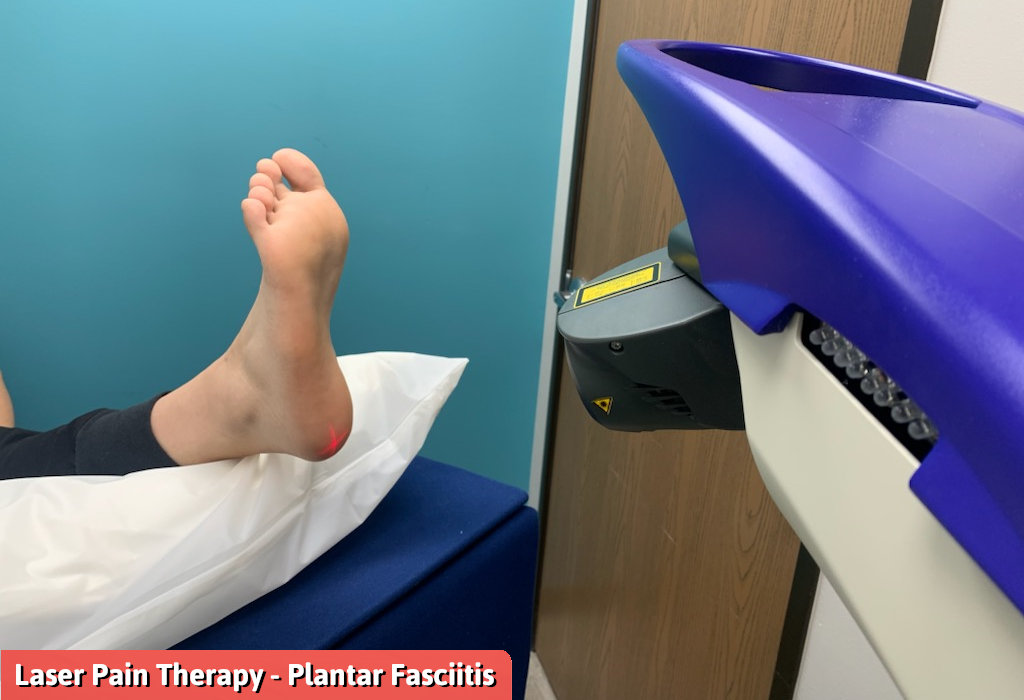
Heel pain is usually caused by plantar fasciitis, and laser therapy is a common noninvasive treatment we recommend. Many suffer from plantar fasciitis because it’s a very common problem. If you have heel pain, there are many treatments you will hear about.
How Do You Know If You Have Plantar Fasciitis?
Plantar fasciitis usually causes pain in the bottom of the heel bone. Often when you first get up in the morning is when it’s most painful. It’s thought that as you step down, the fascia, which is a strong fibrous band of connective tissue that extends from the ball of the foot to where it attaches to the heel bone, will be pulled. This is thought to cause damage to the fascia as the pulling may create microscopic tears where it attaches to the heel bone.
What is Important For You to Understand Before We Discuss How Laser Therapy for Plantar Fasciitis Can Help ?
Additional treatment methods for plantar fasciitis pain are
- Stretching – Stretching is commonly recommended and although it may help for many, it may give a band aid approach, often not permanently resolving the problem.
- Orthotic Devices – Custom made inserts may be very useful to help support the foot and decrease the pulling of the fascia from the heel bone. This pulling is thought to be the root cause of the problem.
- Cortisone Injections – Cortisone can give temporary relief and is seldom a permanent solution.
- Restorative Medicine – This form of treatment is highly successful and involves using human cellular tissue products such as stem cells. These are commonly derived from the placenta or umbilical cord to be injected into the area to repair the damaged tissues.
- Surgery – When conservative measures fail, surgery may be performed. The surgery is done endoscopically through small incisions. A portion of the plantar fascia is released allowing it to be lengthened. Patients ambulate immediately in a cam walker for approximately 3 weeks.
Laser Basics
Laser treatment has been an important part of therapy for plantar fasciitis at Anderson Podiatry center for many years. It is used to help treat many foot and ankle problems. The advantage is that laser therapy offers its safety with no known side effects and is minimally invasive. The treatments are not painful and the lasers we use are robotic cutting-edge lasers. Our lasers are class IV level laser therapy lasers. The laser beam is set to trace over the area needing treatment. Our lasers are FDA approved cold lasers meaning there will be no heat generated or low level intensity during the treatment. The other class of lasers are called hot lasers. These lasers are used to destroy tissue such as warts or cut through tissues in surgery.
To understand how our cutting-edge lasers work we must first understand the mitochondria. Our lasers are deeply penetrating allowing for much more therapeutic value then most lasers. If you are up to speed in health, you may have heard about the mitochondrial. When you investigate a cell in your body, whether it’s a bone cell, muscle cell, or in this situation, the cells in the fascia of the foot, there is an area inside the cell called the mitochondria. The mitochondria is very important as it creates energy for the cell, repairs the cell and gets rid of toxins in the cell. When asked how a laser can help, you may often be told it gets rid of inflammation in the area, it increases blood flow and helps repair the tissues. These may all be true, however research shows that it all gets back to improving the function of the mitochondria.
Currently you may have heard that other things can improve the function of your mitochondria. This may include fasting, exposure to sunlight and getting good sleep. So, think of laser as a therapy that can add to your mitochondria to repair your body. In this situation it’s your damaged fascia.
How Is Laser Therapy for Plantar Fasciitis Performed?
Generally, laser treatments involve 6 to 12 treatments. With each treatment you will gradually experience reduction of pain. How fast and how much relief you get can vary. Laser is frequently used in combination with other treatments such as orthotics, restorative medicine etc. And for many, it does NOT become a maintenance program where you periodically need to keep coming in for more treatments.
We have had great success with laser therapy for plantar fasciitis because it is a low invasive and pain free treatment. We like this approach as we feel it’s really getting to the root cause of the problem by promoting your body’s own processes to heal the fascia which has been damaged. Our multilevel approach of using laser in combination with other treatments such as orthotics and restorative medicine, allows us to have a high success rate because we were attacking the root cause.
by Dr James Anderson, DPM, ABPS, FACFS, FAENS
Call us today at our Fort Collins location (970) 329-8158, Broomfield location (303) 997-2795, Surgery Center (970) 329-8158, or use our online scheduling system to book your appointment.


